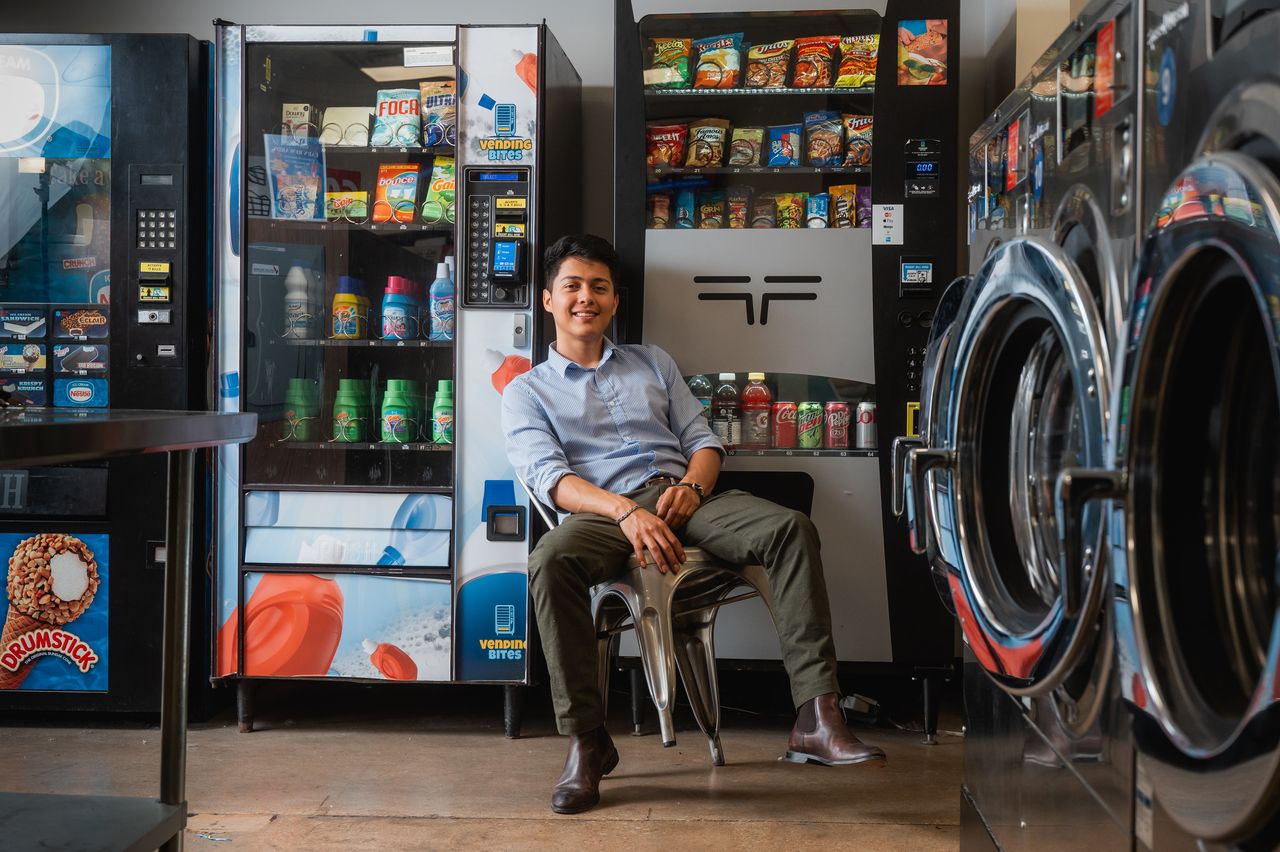Chasing Passive Income, Americans Turn to Vending Machines
How candy and soda machines became an unlikely trending investment idea of the 2020s
With a brick of cash in his hand and a grin on his face, Jaime Ibanez shows his half-million YouTube subscribers a path to earning money without burning many calories: Vending machines.
In videos with titles such as “This Is HOW MUCH My Vending Machines Made IN 7 DAYS!!” the swoopy-haired 23-year-old Texan makes the rounds to his 51 machines, stocking them and taking the profits.
His channel promotes the idea that with diligence and luck, anyone can go from snacks to riches.
Vending machines might seem an unlikely candidate for trending investment of the 2020s, but the idea has captured the imagination of Americans dreaming of easier money. Some pursue chips and soda as a side hustle because their regular paychecks aren’t enough for them to get by. Others bet on vending machines as a ticket to upward mobility, to quitting their jobs and becoming their own boss.
The startup cost is low and the formula simple. Buy a used machine for $1,500, load it up with products from Costco , charge a 100% markup and let the crinkled dollars roll in. But turning a profit takes real work, and the machines can be a losing proposition when stuck in locations without enough hungry foot traffic.
There is a fair amount of competition, too. America has three million vending machines, an $18.2 billion industry, with the average machine generating about $525 in monthly revenue, according to the National Automatic Merchandising Association.
More than half of operators bring in less than $1 million a year, according to trade publication Automatic Merchandiser. Many are individuals who have other jobs.
Social media has fuelled the notion of finding financial freedom in vending machines. Between 2019 and 2023, the number of posts or comments mentioning passive income and vending machines more than tripled on X and increased by a factor of six on Instagram, according to Sprinklr, a social-media management platform. Google search interest in passive income increased some 75% during that same period.
“There’s a real sense that doing things the so-called right way won’t necessarily land you in the middle class,” said Lana Swartz, a media-studies professor at the University of Virginia who researches financial technologies. “If the old rules no longer apply, then there’s a searching for new rules to get ahead or to get by.”
Some vending-machine newbies say they are on their way to building an automated empire. Others’ dreams get snagged like a bag of Funyuns on a faulty coil.
Making sales while you sleep
Last spring Rob Smith, a 30-year-old truck driver in Orlando, Fla., spent $4,000 on his first machine, a credit-card reader and a load of snacks and drinks.
He recently acquired his fourth machine, which is at an industrial bakery. His first three machines take up three to five hours of his week and bring in about $1,500 a month in revenue, which works out to roughly $750 in profit.
“I’ve made sales at four o’clock in the morning, when I was sleeping,” he said. “That machine is still working whether I’m there or not.”
He hopes to scale up to 30 machines and quit his job.
Smith started looking for extra income because his goal of buying a house felt out of reach with only his day job’s pay. He chose vending specifically after he witnessed a colleague complain about a malfunctioning machine at work and then use it anyway.
“He still put his $2 in,” Smith said. “I was like, ‘I need to get a vending machine as soon as possible.’ ”
Some budding vendors pay $300 or more for online courses to learn the trade. Smith relied on YouTube, Instagram and Reddit to get going.
At one point, he stocked a machine with orange soda against the advice he got in an online forum. When it didn’t sell, he and his family had to drink three dozen cans themselves.
Empty calories
Tom and Missi Hakes of Midway, Ala., started vending after Missi, 40, saw videos on YouTube about the business. The idea seemed more appealing than their stints driving for Uber, shopping for Instacart and trying to make it as YouTubers.
The Hakes, who both have full-time jobs in health insurance, scouted out locations in Atlanta, the closest big city and two hours away. After their best lead fell through, they paid a woman they found on Facebook Marketplace $500 to find a location for them.
She sent them to two spots that didn’t work out, including a cheerleading gym. The manager there was on board until she learned that the Hakes hadn’t operated a vending machine before.
Tom, 48, posted on a forum wondering how to address questions about their industry experience. At their next meeting, with the owner of a gym, they reluctantly followed some of the forum’s advice: They lied and said they had a few machines.
“We didn’t want to get another no,” said Tom.
He then spent a month repairing a used machine they bought for $1,400, staying up on some nights until 2 a.m.
When it was ready, Tom and Missi struggled to wrangle it into the 15-foot U-Haul truck they rented.
“Two people is not enough to move an 800-pound machine,” she said.
The Hakes spent about $2,500 on their vending business, as well as 20 to 30 hours a week for much of last fall.
They pay $50 a month to park it in the gym and it costs about $330 to fill up. It is currently grossing about $30 a week.
If anything, the income has been too passive, Tom said, “because it’s not really doing a lot of sales.”
If the machine isn’t selling more by summer, the Hakes will consider leaving the location, or perhaps vending machines overall.
Hit Facebook Marketplace, then Costco
Used vending machines of questionable quality sell online for as little as $500. More reliable ones cost in the range of $1,000 to $2,000, according to veteran vendors. A new machine with a touch screen and a robotic arm could cost upward of $7,000.
Many used machines have a maintenance issue about once a year, and they need to be cleaned. Cash is dirty, said Ben Gaskill of Everest Ice and Water Systems, a vending-machine maker. “Somebody digs around for coins in the bottom of their purse and it’s got grape jelly on it.”
Vendors shop warehouse stores like Costco and Sam’s Club to stock up. One machine’s worth of snacks or drinks can cost $200 to $300 a month. Owners then charge about twice what they paid for each product, or more. Prices of food from vending machines were up 10.6% year over year in January, according to Labor Department data.
The top-selling items in vending machines are cold drinks, snacks and candy, according to the latest data from Automatic Merchandiser magazine.
“No matter how healthy you try to make the machines, people are going to buy that Snickers bar,” said Lory Strickland, who sells courses and one-on-one coaching with her husband, Barry, under the name The Vending Mentors.
A never-vending story
Selling online classes and coaching can sometimes be more lucrative than a given moneymaking idea itself, said Swartz, the University of Virginia professor.
In online forums, she said, “there’s the joke that if there are people making courses about it, then it’s already oversaturated as a side hustle.”
To capitalise on interest in vending, some experienced operators started selling their expertise to supplement the income coming in from their machines. Some transitioned primarily to training.
Hyping the vending-machine dream predates the internet, though. The first machines in the U.S. sold gum and appeared on train platforms in 1888.
In the 1940s, media outlets cautioned about “get-rich-quick schemes” promoted by “unscrupulous agents involving vending machines.” In 1960, the magazine now known as Kiplinger Personal Finance warned of “vultures in the business” who promised “that an $800 investment may produce $200 a month, and that only a few hours of work a week are required to enjoy such rich pickings.”
 Copyright 2020, Dow Jones & Company, Inc. All Rights Reserved Worldwide. LEARN MORE
Copyright 2020, Dow Jones & Company, Inc. All Rights Reserved Worldwide. LEARN MORE
This stylish family home combines a classic palette and finishes with a flexible floorplan
Just 55 minutes from Sydney, make this your creative getaway located in the majestic Hawkesbury region.
Continued stagflation and cost of living pressures are causing couples to think twice about starting a family, new data has revealed, with long term impacts expected
Australia is in the midst of a ‘baby recession’ with preliminary estimates showing the number of births in 2023 fell by more than four percent to the lowest level since 2006, according to KPMG. The consultancy firm says this reflects the impact of cost-of-living pressures on the feasibility of younger Australians starting a family.
KPMG estimates that 289,100 babies were born in 2023. This compares to 300,684 babies in 2022 and 309,996 in 2021, according to the Australian Bureau of Statistics (ABS). KPMG urban economist Terry Rawnsley said weak economic growth often leads to a reduced number of births. In 2023, ABS data shows gross domestic product (GDP) fell to 1.5 percent. Despite the population growing by 2.5 percent in 2023, GDP on a per capita basis went into negative territory, down one percent over the 12 months.
“Birth rates provide insight into long-term population growth as well as the current confidence of Australian families,” said Mr Rawnsley. “We haven’t seen such a sharp drop in births in Australia since the period of economic stagflation in the 1970s, which coincided with the initial widespread adoption of the contraceptive pill.”
Mr Rawnsley said many Australian couples delayed starting a family while the pandemic played out in 2020. The number of births fell from 305,832 in 2019 to 294,369 in 2020. Then in 2021, strong employment and vast amounts of stimulus money, along with high household savings due to lockdowns, gave couples better financial means to have a baby. This led to a rebound in births.
However, the re-opening of the global economy in 2022 led to soaring inflation. By the start of 2023, the Australian consumer price index (CPI) had risen to its highest level since 1990 at 7.8 percent per annum. By that stage, the Reserve Bank had already commenced an aggressive rate-hiking strategy to fight inflation and had raised the cash rate every month between May and December 2022.
Five more rate hikes during 2023 put further pressure on couples with mortgages and put the brakes on family formation. “This combination of the pandemic and rapid economic changes explains the spike and subsequent sharp decline in birth rates we have observed over the past four years,” Mr Rawnsley said.
The impact of high costs of living on couples’ decision to have a baby is highlighted in births data for the capital cities. KPMG estimates there were 60,860 births in Sydney in 2023, down 8.6 percent from 2019. There were 56,270 births in Melbourne, down 7.3 percent. In Perth, there were 25,020 births, down 6 percent, while in Brisbane there were 30,250 births, down 4.3 percent. Canberra was the only capital city where there was no fall in the number of births in 2023 compared to 2019.
“CPI growth in Canberra has been slightly subdued compared to that in other major cities, and the economic outlook has remained strong,” Mr Rawnsley said. “This means families have not been hurting as much as those in other capital cities, and in turn, we’ve seen a stabilisation of births in the ACT.”
This stylish family home combines a classic palette and finishes with a flexible floorplan
Just 55 minutes from Sydney, make this your creative getaway located in the majestic Hawkesbury region.





















